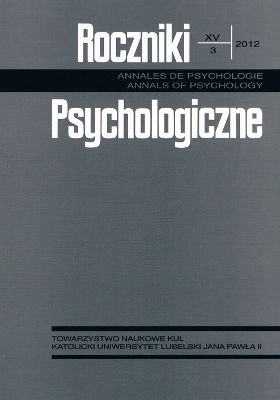Profile-based analysis of executive dysfunctions in neuropsychological examination of patients after stroke
Abstract
Executive dysfunction (ExD) is a relatively common new diagnostic entity, which includes variety of symptoms of disorganized behavior, such as loss of ability to programming, initiating, and controlling ongoing actions. One of the most common origin of ExD is ischaemic stroke. Forty-three patients following unilateral hemispheric stroke were submitted to five tasks of executive functions, which is believed to measure an overall flexibility of problem solving (Wisconsin Card-Sorting Test), ability to switch of attention (Trail Making Test, Controlled Oral Word Association Test), and inhibitory control processes (Stroop Color-Word Test, go/no-go task). Subjects were divided into three anatomically-defined groups. The area of structural damage was limited entirely to the respective frontal lobe, subcortical region (mostly striatum, thalamus, and/or internal capsule) or posterior (non-frontal) cortices. All brain lesions were verified by CT or MR scan. Also, 25 healthy subjects took part in the study. Results showed: (a) patients’ group manifested variety of ExD which were heterogeneous with respect to severity and character, (b) the most severe deficit was disinhibition of automatic response in go/no-go task, (c) the patients with frontal or subcortical lesions had more difficulties controlling (inhibiting) ongoing verbal and motor responses than the patients with posterior cerebral lesions, (d) utility of profile-based analysis (pattern analysis of test scores) was emphasized in diagnosis of intraindividual heterogeneity in executive functioning after stroke. For instance, a strong association was found between extent of intraindividual differences of test scores and the overall severity of ExD.
References
Członkowska, A., Sarzyńska-Długosz, I. (2005). Epidemiologia udaru mózgu. W: B. Strosznajder, Z. Czernicki (red.), Mózg a niedokrwienie (s. 164-191). Kraków: Wydawnictwo Platan.
Damasio, H., Damasio, A. R. (1989). Lesion analysis in neuropsychology. New York: Oxford University Press.
Godefroy, O. (2003). Frontal syndrome and disorders of executive functions. Journal of Neurology, 250, 1-6.
Godefroy, O., Stuss, D. (2007). Dysexecutive syndromes. W: O. Godefroy, J. Bogousslavsky (red.), The behavioral and cognitive neurology of stroke (s. 369-406). New York: Cambridge University Press.
Golden, C. J. (1976). Identification of brain disorders by The Stroop Color and Word Test. Journal of Clinical Psychology, 32, 654-658.
Jaworowska, A. (2002). Test Sortowania Kart z Wisconsin. Podręcznik (polska adaptacja). Warszawa: Pracownia Testów Psychologicznych PTP.
Jodzio, K. (2008). Neuropsychologia intencjonalnego działania. Koncepcje funkcji wykonawczych. Warszawa: Wydawnictwo Naukowe Scholar.
Jodzio, K. (2010). Od poznania do dezorganizacji działania, czyli dysfunkcje wykonawcze po udarze mózgu. W: K. Jodzio, E. M. Szepietowska (red.), Neuronalne ścieżki poznania i zachowania. Rozważania interdyscyplinarne (s. 113-129). Lublin: Wydawnictwo Uniwersytetu Marii Curie-Skłodowskiej.
Jodzio, K. (2011). Diagnostyka neuropsychologiczna w praktyce klinicznej. Warszawa: Difin.
Jodzio, K., Biechowska, D. (2010). Wisconsin Card-Sorting Test as a measure of executive function impairments in stroke patients. Applied Neuropsychology, 17, 267-277.
Jodzio, K., Biechowska, D., Gąsecki, D. (2008). Objawowa i neuroanatomiczna charakterystyka zespołu dysfunkcji wykonawczej po udarze mózgu. Studia Psychologiczne, 46, 19-34.
Kądzielawa, D. (red.) (1990). Podręcznik do Baterii Testów Neuropsychologicznych Halsteada-Reitana (mps, Wydział Psychologii Uniwersytetu Warszawskiego w Warszawie).
Lezak, M. (1982). The problem of assessing executive functions. International Journal of Psychology, 17, 281-297.
Macmillan, M. (1996). The concept of inhibition in some nineteenth century theories of thinking. Brain and Cognition, 30, 4-19.
Matczak, A. (1994). Diagnoza intelektu. Warszawa: Wydawnictwo Instytutu Psychologii PAN.
Miller, B. L., Cummings, J. L. (red.) (2007). The human frontal lobes: Functions and disorders. New York: The Guilford Press.
Mroziak, J. (1992). Równoważność i asymetria funkcjonalna półkul mózgowych. Warszawa: Wydział Psychologii UW.
Ross, T. P. (2003). The reliability of cluster and switch scores for the Controlled Oral Word Association Test. Archives of Clinical Neuropsychology, 18, 153-164.
Sherer, M., Krull, K. R., Adams, R. L. (1995). Interpretive significance of variability of performance on neuropsychological tests. Applied Neuropsychology, 2, 39-41.
Stuss, D. T., Murphy, K. J., Binns, M. A., Alexander, M. P. (2003). Staying on the job: The frontal lobes control individual performance variability. Brain, 126, 2363-2380.
Szepietowska, E. M., Gawda, B. (2011). Ścieżkami fluencji werbalnej. Lublin: Wydawnictwo UMCS.
Toczek, S. (1961). Zaburzenia procesu hamowania po uszkodzeniu okolicy czołowej mózgu u człowieka. W: J. Konorski, H. Koźniewska, L. Stępień, J. Subczyński (red.), Z zagadnień patofizjologii wyższych czynności nerwowych po uszkodzeniach mózgu u człowieka (s. 145-179). Warszawa: Państwowe Wydawnictwo Naukowe. Rozprawy Wydziału Nauk Medycznych PAN.
Tomaszewski, T. (1967). Aktywność człowieka. W: M. Maruszewski, J. Reykowski, T. Tomaszewski (red.), Psychologia jako nauka o człowieku (s. 221-278). Warszawa: Książka i Wiedza.
Vataja, R., Pohjasvaara, T., Mäntylä, R., Ylikoski, R., Leppävuori, A., Leskelä, M., Kalska, H., Hietanen, M., Aronen, H. J., Salonen, O., Kaste, M., Erkinjuntti, T. (2003). MRI correlates of executive dysfunction in patients with ischaemic stroke. European Journal of Neurology, 10, 625-631.
Copyright (c) 2011 Roczniki Psychologiczne

This work is licensed under a Creative Commons Attribution-NonCommercial-NoDerivatives 4.0 International License.


